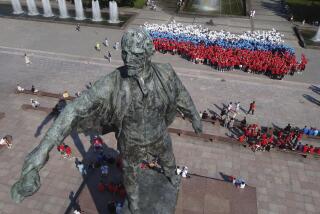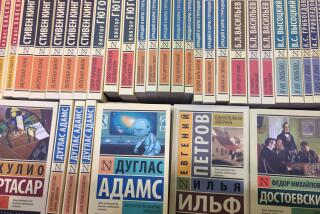Gorbachev Cleans Up a Cliche : Khrushchev’s ‘Peaceful Coexistence’ Was a Ruse
- Share via
Perhaps the most important pages for the West in Mikhail S. Gorbachev’s book, “Perestroika,” proclaim the burial of that maddeningly deceptive phrase “peaceful coexistence.” In several carefully worded paragraphs drawn from earlier speeches, Gorbachev provides the ideological reasoning behind his leadership’s decision to eliminate the Soviet definition of peaceful coexistence as “a specific form of class struggle.”
Peaceful coexistence was the sweet-sounding formulation that the first post-Stalin Soviet reformer, Nikita S. Khrushchev, brought to the first superpower summit in the United States in 1959. Khrushchev’s siren call to the American public was expounded in a hopeful, but not altogether candid, article in Foreign Affairs, published (as Gorbachev’s book was) on the eve of his visit with the American President.
The essence of Khrushchev’s message was that, because of the existence of nuclear weapons and the power and influence of the “socialist camp,” a third world war was no longer “fatally inevitable.” The Soviets’ ideological reassessment, which held that the ultimate “class struggle” between “communist” and “capitalist” states would not “inevitably” culminate in a war that would eliminate capitalism forever, was an important step forward. It promoted a thaw in the Cold War.
Yet, intrinsic in peaceful coexistence were several notions that were unacceptable to Western statesmen. Khrushchev stressed in his article a firm belief that the “socialist” system would win over “capitalism,” based on his “knowledge of the scientific basis governing the development of society.” Also, implicit in all the Soviet writings on peaceful coexistence was the notion that while the United States and the Soviet Union should not go to war or interfere in one another’s internal affairs, the rest of the world was free game; the “class struggle” and “ideological struggle” would intensify to hasten the inevitable triumph of socialism. And war, although not “inevitable,” still was a means of bringing about the end of capitalism.
To many in the West, even to this day, “peaceful coexistence” has a certain pragmatic appeal. But to those who read what the Soviets intended, the phrase was an offensive propaganda device to conceal the underlying hostility between East and West. George Kennan in his 1960 Foreign Affairs reply to Khrushchev’s article expressed eloquently the rage that many students of Soviet politics felt. After analyzing the preposterous pretensions of Khrushchev’s article, Kennan concluded:
“So long as the leaders of the Communist Party of the Soviet Union continue to hold that truth is what is useful to the interests of the Party, even those people in other parts of the world who might most earnestly wish for coexistence as Mr. Khrushchev has defined it will have to put restraints on their hopes and expectations.”
Now, nearly 30 years later, Gorbachev, this second Soviet reformer, has taken the party several important steps beyond Khrushchev. The certitude and ideological arrogance of Khrushchev is muted. Gorbachev is a true believer but he does not daily preach the triumph of communism. In fact, much of his book and his daily message to the Soviet people is that socialism is a mess and needs fixing.
Most important, from our point of view, may be his burying of “peaceful coexistence.” Last summer at the U.S.-Soviet Chautauqua meeting, during a debate with two top Soviet ideologists,I said that I welcomed Gorbachev’s announced intention to reduce the “ideological and class struggle” component of Soviet foreign policy. A young Pravda correspondent rebuked me for not realizing that “under present conditions” the class and ideological struggle would intensify while state relations improved. Soviet academician Yevgeny M. Primakov told the reporter that he was out of date, that I was correct, and lectured the earnest young ideologue on the new party line. This exchange was a metaphor for a changing Soviet society. When the ideology becomes confusing, it becomes less dangerous.
In divorcing “class struggle” from “foreign policy” and “revolution” from “war,” Gorbachev laid the ideological ground work for a more pragmatic foreign policy. He explains in his book that his leadership eliminated from the old Communist Party program two key sentences that admitted the possibility of a third world war, one that would “sweep imperialism away and bury it”--a quintessential Khrushchevian formulation. Gorbachev is saying that war is not a valid means of defeating capitalism.
Now we must wait and see what this means in practice. Gorbachev was careful in his dissertation not to disengage completely from the class-struggle component. He cannot. He is a Communist. Over time, will the Soviet client states (Cuba, Vietnam, Ethiopia, Nicaragua) cease the promotion of “class struggle” or “revolution?” Will the Soviet Union cease its support for those Communist parties that advocate violent revolution, such as in Chile, El Salvador and Honduras? Will the Soviet Union resist the temptation to engage in opportunities for “national liberation” in such trouble areas as the Philippines? Will the Soviet Union disengage from the Communist regime in Afghanistan? Will the Soviet Union allow real social and political change in Eastern Europe if the people of those nations so desire?
These are not simple tasks for Gorbachev. Seventy years of national habits and ideology do not change with the burial of a slogan. Even though the new slogans of perestroika , glasnost and the other “new thinking” are not heralding a free and open Soviet society, they have moved the Soviets and the superpower relationship beyond the realm of peaceful coexistence.
The danger always is: Will “peaceful coexistence” be redefined again; will the “inevitability of war” re-emerge?
In the early 1960s there was a joke about Khrushchev telephoning Golda Meir to ask whether Stalin’s body could be taken from the Red Square mausoleum and buried in the Dead Sea in exchange for the establishment of Soviet-Israeli diplomatic relations. After consultation with her cabinet, Prime Minister Meir told Khrushchev that the government of Israel would agree, but reminded him that Israel has the highest rate of resurrection of any country in the world.
Let’s hope that “peaceful coexistence” and Stalin stay buried.
More to Read
Sign up for our Book Club newsletter
Get the latest news, events and more from the Los Angeles Times Book Club, and help us get L.A. reading and talking.
You may occasionally receive promotional content from the Los Angeles Times.







